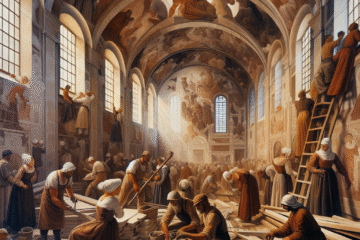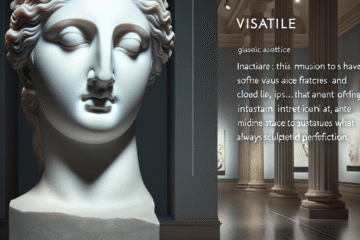Introduction
Art has been an integral part of human civilization for thousands of years, with various styles and forms influencing and being influenced by the cultures and societies in which they were created. Among the most influential art styles in Western civilization are Greek and Roman art.
A. Definition of Greek and Roman Art
Greek art refers to the visual arts produced in Ancient Greece from the 8th century BCE to the 4th century CE. It encompasses a wide range of styles and techniques, including sculpture, pottery, painting, and architectural design. The art of Ancient Greece is characterized by its classical forms, intricate details, and emphasis on ideal beauty and harmony.
Roman art, on the other hand, refers to the visual arts produced in Ancient Rome from the 8th century BCE to the 5th century CE. Roman art was heavily influenced by Greek art and often incorporated elements of Greek styles into their own works. Roman art is characterized by its realism and attention to detail, as well as its grandiose and monumental style, particularly in architecture.
B. Importance of Greek and Roman Art in Western Civilization
Greek and Roman art have had a profound impact on Western civilization, serving as a foundation for artistic expression and influencing generations of artists and designers. The classical forms and ideals of beauty seen in Greek art have been revered and emulated for centuries, while the realism and grandeur of Roman art have inspired countless works of art and architecture.
Additionally, the achievements of Greek and Roman artists in sculpture, pottery, painting, and architecture have set a standard for artistic excellence and technical mastery, serving as a benchmark for artists throughout the ages.
C. Overview of the article
This article will explore the beginnings of Greek and Roman art, as well as the key characteristics that define these styles. We will also examine the influence of Greek and Roman art on Western civilization, tracing its impact from the Middle Ages to the present day. By the end of this article, readers will have a better understanding of the significance of Greek and Roman art in Western civilization and its lasting legacy.
II. The Beginnings of Greek Art
The art of Ancient Greece developed over thousands of years, with various styles and techniques emerging and evolving over time. In this section, we will explore the key periods of Greek art and the development of Greek art over time.
A. Archaic Period (8th to 6th century BCE)
The Archaic Period of Greek art is defined by the emergence of a new style of art and a new cultural identity. This period saw the first major works of Greek sculpture, as well as the development of pottery and vase painting. Archaic Greek art is characterized by its stylized forms and the use of the stylobate, a flat base used to support the statue.
B. Classical Period (5th to 4th century BCE)
The Classical Period of Greek art saw the height of Greek artistic achievement, with the creation of some of the most iconic works of Greek art, including the Parthenon, the Nike of Samothrace, and the Venus de Milo. During this period, Greek art became more naturalistic and focused on representing the human form in a realistic and idealized manner. The classical ideals of harmony, balance, and proportion became central to Greek art and architecture.
C. Hellenistic Period (3rd to 1st century BCE)
The Hellenistic Period of Greek art saw the expansion of Greek culture throughout the Mediterranean world and the creation of some of the most emotionally charged and dynamic works of Greek art. This period saw the rise of individual expression and a more elaborate and decorative style, with a greater emphasis on realism and the portrayal of emotion.
D. The Development of Greek Art
Greek art developed over thousands of years, with various styles and techniques emerging and evolving over time. From the stylized forms of the Archaic Period to the classical ideals of beauty and harmony in the Classical Period to the emotional expressiveness of the Hellenistic Period, Greek art is marked by a constant evolution and a drive towards artistic excellence.
E. The Key Characteristics of Greek Art
Greek art is characterized by its classical forms, intricate details, and emphasis on ideal beauty and harmony. Greek artists sought to represent the human form in a naturalistic and idealized manner, striving for balance, proportion, and harmony in their works. Greek art also reflects the values and beliefs of Greek society, with a focus on the heroic and the divine. These key characteristics have made Greek art one of the most enduring and influential styles in Western civilization.
III. The Roman Art
The art of Ancient Rome developed over several centuries, with various styles and techniques emerging and evolving over time. In this section, we will explore the key periods of Roman art and the development of Roman art over time.
A. The Roman Republic (509 to 27 BCE)
The Roman Republic was a period of great expansion and growth for the Roman Empire, and it saw the emergence of a new style of art that incorporated elements of Greek styles. Roman art during this period was characterized by its realism and attention to detail, as well as its grandiose and monumental style, particularly in architecture.
B. The Roman Empire (27 BCE to 476 CE)
The Roman Empire was a period of great power and prosperity for the Roman people, and it saw the height of Roman artistic achievement. Roman art during this period was heavily influenced by Greek art, with a focus on grandiose and monumental styles. Roman artists created some of the most impressive works of art and architecture in the ancient world, including the Colosseum and the Pantheon.
C. The Development of Roman Art
Roman art developed over several centuries, with various styles and techniques emerging and evolving over time. From the realism and grandeur of the Roman Republic to the monumental styles of the Roman Empire, Roman art is marked by a constant evolution and a drive towards artistic excellence.
D. The Key Characteristics of Roman Art
Roman art is characterized by its realism and attention to detail, as well as its grandiose and monumental style, particularly in architecture. Roman artists sought to create works of art that reflected the power and prestige of the Roman Empire, with a focus on grandeur and monumental styles. Roman art is also marked by its incorporation of elements of Greek styles, reflecting the influence of Greek culture on Roman society. These key characteristics have made Roman art one of the most impressive and influential styles in Western civilization.
IV. The Influence of Greek and Roman Art on Western Civilization
Greek and Roman art has had a profound impact on Western civilization, influencing artistic styles and techniques for centuries. In this section, we will explore the ways in which Greek and Roman art has influenced Western art and culture over the course of several key historical periods.
A. Greek and Roman Art in the Middle Ages (5th to 15th century)
During the Middle Ages, Greek and Roman art was rediscovered and reinterpreted by the Western world, leading to a revival of classical styles and techniques. This period saw the rise of Gothic architecture, which incorporated elements of classical styles, and the creation of illuminated manuscripts, which were heavily influenced by classical motifs and designs.
B. The Renaissance (14th to 17th century)
The Renaissance was a time of great artistic and cultural revival in Europe, marked by a renewed interest in classical styles and techniques. During this period, artists such as Michelangelo and Raphael rediscovered the classical styles of Greek and Roman art, incorporating them into their own works and inspiring a new generation of artists. The Renaissance was a time of great artistic innovation, with artists exploring new techniques and styles, and paving the way for the modern era.
C. The Enlightenment (17th to 18th century)
During the Enlightenment, Greek and Roman art continued to have a significant impact on Western art and culture. The classical styles and techniques of ancient Greece and Rome inspired artists and thinkers, who sought to incorporate elements of classical art into their own works. The Enlightenment was a time of great intellectual and cultural ferment, with artists and thinkers exploring new ideas and styles, and paving the way for the modern era.
D. The Modern Era (19th to 20th century)
In the modern era, the influence of Greek and Roman art can still be seen in many forms of Western art and culture. From the classical revival in architecture, to the incorporation of classical motifs and designs in visual arts, Greek and Roman art continues to inspire and influence artists and designers today. Whether in the realm of fine art, architecture, or popular culture, the legacy of Greek and Roman art can be seen in many forms in the Western world today.
In conclusion, Greek and Roman art has had a profound and lasting impact on Western civilization, influencing artistic styles and techniques for centuries. From the Middle Ages to the modern era, Greek and Roman art has inspired artists, designers, and thinkers, and continues to influence the Western world in countless ways.
V. Conclusion
The influence of Greek and Roman art on Western civilization is undeniable, with its impact felt in countless forms of art and culture throughout history. In this article, we have explored the beginnings of Greek and Roman art, its development, key characteristics, and its lasting impact on Western civilization.
A. Summary of the Influence of Greek and Roman Art on Western Civilization
Greek and Roman art has had a profound impact on Western civilization, influencing artistic styles and techniques for centuries. From the Middle Ages to the modern era, Greek and Roman art has inspired artists, designers, and thinkers, and continues to influence the Western world in countless ways. The classical styles and techniques of ancient Greece and Rome continue to inspire and inform contemporary art and design, and the legacy of these ancient cultures lives on.
B. Reflection on the Legacy of Greek and Roman Art
The legacy of Greek and Roman art is an enduring one, with its impact felt in countless forms of Western art and culture. From the towering columns of classical architecture, to the intricate designs of illuminated manuscripts, the influence of Greek and Roman art can be seen in many forms in the Western world today. Whether in the realm of fine art, architecture, or popular culture, the legacy of Greek and Roman art continues to inspire and influence artists and designers, and is a testament to the enduring power of these ancient cultures.
C. Final Thoughts and Recommendations for Further Study
The influence of Greek and Roman art on Western civilization is a fascinating and complex subject, and there is much more to be learned and explored. If you are interested in learning more about Greek and Roman art and its impact on Western civilization, there are many excellent resources available, including books, museum exhibitions, and online resources. Whether you are a student of art history, or simply a curious reader, we encourage you to delve deeper into this rich and fascinating subject, and explore the many ways in which Greek and Roman art continues to influence and inspire the Western world.


